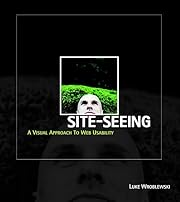

Cliquer sur une vignette pour aller sur Google Books.
|
Chargement... Site-Seeing: A Visual Approach to Web Usability (édition 2002)par Luke Wroblewski
Information sur l'oeuvreSite-Seeing: A Visual Approach to Web Usability par Luke Wroblewski
 Aucun Actuellement, il n'y a pas de discussions au sujet de ce livre.  A site’s visual design has a direct and profound impact on how we perceive, use, and navigate web sites. This book contains hundreds of well thought-out examples from the web to illustrate this point. Wroblewski covers the design of many navigation mechanisms in detail, as well as use of space, color, fonts, and many other visual design elements. aucune critique | ajouter une critique
Although Web usability has received lots of hype, especially during the dot-com meltdown, the focus has been mostly on technical issues. Usability experts stress the pitfalls of frames and too many images on Web pages. They recommend editing out unnecessary words and writing in a non-linear style-all valuable advice, of course. But less frequently do they highlight the importance of the visual presentation of Web pages. The Web is a communication medium that does most of its talking visually. What you see on a Web page tells you what you might find within the site, how to get there, and why it might interest you-not to mention the instinctive emotional response that shapes your Web experience. As a result, Web usability issues are communication issues. Easy-to-use sites are those that communicate quickly and effectively. Site-Seeing takes a fresh approach to Web usability by applying visual communication principles and decision-making to Web design. Specifically, readers will learn the key concepts behind visual organization, look and feel, technical considerations, and clear planning that stem from audience awareness. Through numerous, full-color examples author Luke Wroblewski deconstructs "the good, the bad, and the ugly" of Web design. The visual presentation of a site does more than merely making it pretty. It organizes information according to function. It creates distinct and appropriate personalities. It provides emotional impact and attachment. In short, it engages the audience-and keeps them coming back. Aucune description trouvée dans une bibliothèque |
Discussion en coursAucun
 Google Books — Chargement... Google Books — Chargement...GenresClassification décimale de Melvil (CDD)005.72Information Computing and Information Computer programming, programs, data, security Data Preparation and RepresentationClassification de la Bibliothèque du CongrèsÉvaluationMoyenne: (4) (4)
Est-ce vous ?Devenez un(e) auteur LibraryThing. |
||||||||||||||||||||||||||||||||||||||||||||||||||||||||||||||||||||||||||||||||||||||||||||||||||||||||||||||||||||||||||||||||||||||